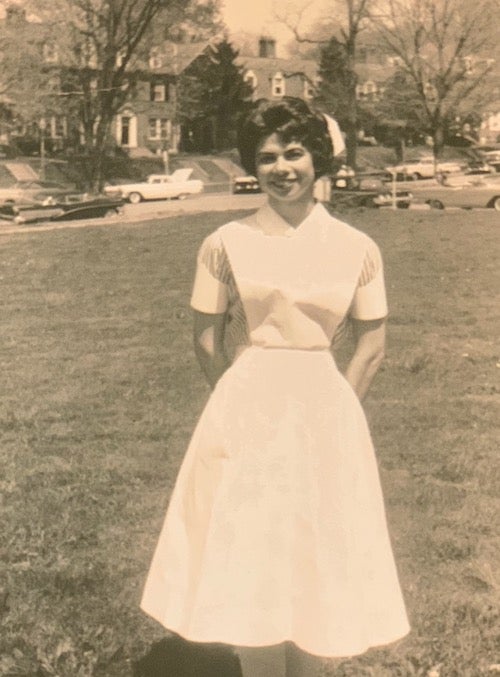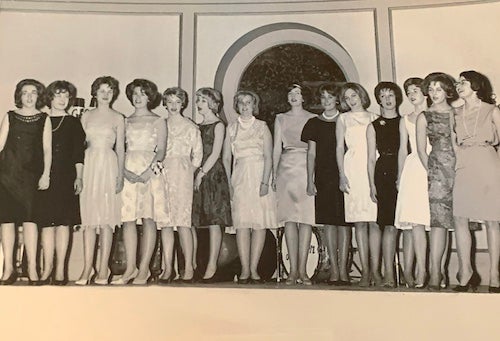Georgetown Nursing Alumna Shares Memories of Education and Hospital Career
July 6, 2021 – When Florence Mahoney’s grandchildren need advice, they generally sit down and begin the conversation with, “Grandma.”
“Usually when they start like that,” the Georgetown nursing alumna who will turn 80 this year quipped, “you know something’s coming.”

Georgetown BSN alumna Florence Mahoney of the Class of 1963 stands in her student nursing uniform with Reservoir Road behind her. (Photo courtesy Mahoney)
Mahoney, who graduated with the BSN in 1963 and worked for 30 years as a surgical nurse at Georgetown University Hospital, says she encourages them to pursue their interests, accept opportunities, and seek the work they really love.
Finding Georgetown
Recently, Mahoney shared some memories from her time as a student at Georgetown and her career as a nurse at Georgetown Hospital.
A religious sister at her high school who taught math and science had encouraged her to attend a bachelor’s program in nursing versus a diploma program.
“She said, ‘Florence, the future is four-year programs,’” Mahoney recalled, “‘Not the three years that everybody is going to.’ And she said, ‘You can do that work, so you need to apply to a four-year program.’”
Mahoney remembered her applicant interview with Sister Kathleen Mary Bohan, SCN, the School of Nursing’s dean. “We all liked her a lot,” she said. “I always found her absolutely wonderful to tell you the truth. I think she was pretty excited that we were cracking the university system. We were going to be part of the university, not just a school of nursing.”
(The students, she said, also liked Father Edward B. Bunn, SJ, the university’s president. They referred to themselves as “Bunn’s GUNS,” she said, referencing the “Georgetown University Nursing School.”)
Rules and Regulations
Mahoney and her classmates – many of whom have stayed in touch during the COVID-19 pandemic at monthly Zoom meetings – started their studies in the fall of 1959. Life in the dorm, which was the then-relatively new, yet un-air-conditioned St. Mary’s Hall on Reservoir Road, was pretty rules-based.
The Sisters of Charity of Nazareth, who were administrators at the hospital and nursing school, lived on the fourth floor. Students were required to attend morning Mass or prayers in the building’s chapel. Dress length, including their blue-and-white-striped uniforms, and makeup were monitored. Interaction with the male students on campus was very limited. And there were certainly no personal displays of affection allowed.
“These rules,” Mahoney joked, “I tell people this, and they look at me like I was there in the 1800s or something.”
Sometimes, the Chimes a capella group would serenade the nursing students under their St. Mary’s windows. “That was so romantic,” she admitted. (The nursing students also had a group called the Charms.)
Four Years and One Summer
The nursing curriculum was demanding and structured, Mahoney noted, including four academic years of coursework and one summer session, when the students learned dissection.
“We had absolutely no choice in what classes we were going to take,” she said. “180 credits without one single choice. They decided everything we needed to know.”
Nursing students in this period of time, she said, did not take courses with the male undergraduates at Georgetown, but they did take chemistry and microbiology with the medical students.
Clinical coursework included rotations at Glendale Sanitarium for tuberculosis and at Walter Reed for psychiatric nursing, as well as public health work at people’s homes in the city.
She always did well in clinical, but received a lower grade once by a lay professor because she did not say the “Act of Contrition” prayer with a patient. (To be fair, Mahoney and a physician were busy trying to save the patient’s life at the time, which they did do.)
Hospital shifts also began with a prayer led by one of the sisters.
1950s and 1960s
A major event, the Cuban Missile Crisis, occurred during her studies in the fall of 1962, when the first-year and sophomore students were sent home.
“They kept the juniors and seniors there so that we could stay at the hospital if it was necessary,” she said, noting that the students were “scared out of our wits.”
Mahoney, who grew up in a small and non-diverse farming community in New York, also described becoming aware of racial segregation for the first time at some DC-area businesses that mandated separate facilities for Black and White patrons.
“It was an appalling situation,” she said, reflecting on the impact of segregation on the lives and livelihoods of the Black community.
Career at Georgetown
After graduation and the boards, Mahoney moved to New Jersey to stay with her mother and work at the VA hospital in Newark. She eventually returned to DC for a three-decade career at Georgetown Hospital.
One memory she shared involved caring for a woman who graduated from the School of Nursing in the very early years of the 20th century. The fellow nursing alumna was amazed at what Mahoney was able to do as a nurse and also put on her makeup to greet the physician during rounds.

Nursing students in the a cappella group the Charms. Mahoney remembers classmate, the late Susan Kreutz Rogers (John Carroll Awardee 1997), opening with the first line of the GU Fight Song, “It’s been so long sing last we met,” and then the rest of the group joining in. (Photo courtesy Mahoney)
She also described a difficult memory of how hospital protocol changed because of HIV/AIDS and how that change impacted her connection with patients.
“When HIV started being diagnosed, that was very hard,” she said. “I felt like I was almost insulting the patients, giving somebody a bath with gloves on. That was really, really hard. And not that I was afraid. I can remember thinking, ‘I’m not insulting you. I have to do this.’”
‘Care of the Whole Person’
Additionally, Mahoney detailed some changes she welcomed in the nursing profession, including when nurses who were charting no longer stood up whenever a physician entered the unit, when nurses began wearing pantsuits instead of the more traditional dresses, and when men entered nursing.
In looking back and reflecting on what nursing meant to her, Mahoney responded, “Care of the whole person, and that’s one thing that Georgetown promoted and was encouraged. That’s how we knew each other.”
By Bill Cessato
- Tagged
- alumni
- Nursing History
